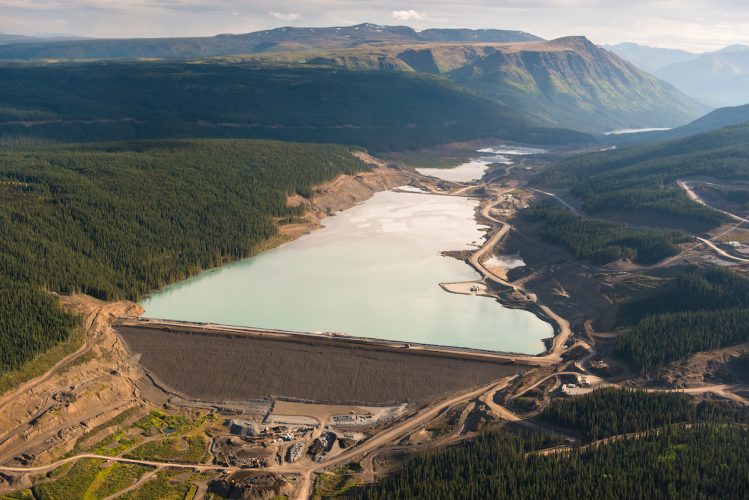
At the Red Chris Mine, a dam contains a tailings pond. that collects mine waste. Northwest B.C., 2017. (Courtesy of Garth Lenz)
Financial analysts say a British Columbia mining company is struggling to survive. Imperial Metals owns the Red Chris mine, in the watershed of the Stikine, a river vital to Southeast Alaska fisheries. This is raising concerns for critics of transboundary mining.
Imperial’s stock is on a steady decline. It’s operating with a negative cashflow. And it has 800 million dollars worth of debt coming down the pipe in just over a year.
Imperial Mines did not respond to an interview request, but its financial standing is detailed in recent press releases. These notices say the company is restructuring and has extended the due dates for certain loans.
Jamie Koutsoukis is an analyst at Moody’s Investors Service, which rates companies’ risk of defaulting. She tracks Canadian metal and mining companies. Her firm recently came out with a report and low-rating for Imperial Metals.
She says Imperial’s top investors are not backing out. They will funnel up to $40 million into the company through a rights offering. Still, Koutsoukis doesn’t think that’s a game-changer.
“They would get $40 million, it would give them some room in terms of having cash available to them, but with $800 million due they’ll have to look at alternative financing as well,” Koutsoukis says.
She says operations have been poor at the Red Chris mine because it is extracting lower grade ore and getting less of it than last year. For Mount Polley mine, the forest fires over the summer stifled operations, shutting the mine down for two weeks with a slow recovery.
Imperial Metals also owns the British Columbia Ruddock Creek project, which is undergoing exploration, and Huckleberry Mine where operations are on hold.
Koutsoukis says this financial strain comes despite rising copper prices.
“I think what’s happening with Imperial is really an anomaly,” Koutsoukis says. “This year we’ve seen increased cashflow, increased earnings, just based on the run-up of the copper price.”
The company’s other operating mine, Mount Polly, has become a symbol for mine critics. In 2014, its dam broke, spilling millions of gallons of mine waste rock and sand. The waste, called tailings, poured into nearby lakes and the Cariboo River.
Some environmentalists, fishermen and tribal leaders worry that similar disasters could contaminate the Stikine and other rivers and tributaries in Southeast Alaska.
That includes the Red Chris, a copper/gold mine in northwest British Columbia, which began operations in July of 2015. Its tailings dam is upstream from the watershed of the Stikine River, which empties into the ocean near Wrangell and Petersburg.
Heather Hardcastle is a spokeswoman for Salmon Beyond Borders. The group advocates for clean waters that support sustainable fishing. The group wants to see more transboundary regulation, so that Canadian mines will be held accountable for any damage done to Alaskan waters.
“Where is the money going to come from to make sure that this mine is first of all operating in a responsible way, which we contend it currently is not, but then also how is it going to be fully reclaimed if this company goes bankrupt,” Hardcastle says.
She wants to see regulation that would keep operators on the hook for pollution from abandoned mines.
“So that companies have to put up a larger enough reclamation bond to cover reclamation in the event of bankruptcy,” Hardcastle says.
She points to British Columbia’s Tulsequah Chief mine, which was abandoned in the 1950s. It continues draining acidic water into the Tulsequah River, which is a tributary of the Taku River, which empties into an ocean near Juneau.
Alaska’s top political leaders agree more accountability in transboundary mining is needed. Alaska’s governor, lieutenant governor and Congressional delegation recently asked our federal government to join the fight.









